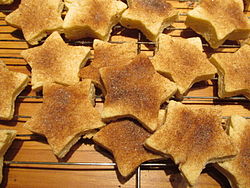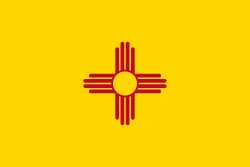 A fresh batch of biscochitos | |
| Alternative names | Biscochito |
|---|---|
| Type | Cookie |
| Place of origin | Nuevo México, New Spain |
| Region or state | New Mexico, USA |
| Associated cuisine | New Mexican cuisine |
| Main ingredients | Butter or pork lard, [1] anise, cinnamon, flour |
The bizcochito or biscochito (diminutive of the Spanish bizcocho ) is a New Mexican crisp butter cookie made with lard, flavored with sugar, cinnamon, and anise. [2] [3] The dough is rolled thin and cut into the shape of the fleur-de-lis, the Christian cross, a star, or a circle, symbolizing the moon. [4]
Contents
The cookie was developed in New Mexico [5] over the centuries from the first Spanish colonists [6] of what was then known as Santa Fe de Nuevo México. The roots of this pastry date back as far as the Battle of Puebla in 1862, where French Emperor Maximilian was overthrown by the Mexicans. This date is now famously recognized in the United States as Cinco de Mayo, literally the "Fifth of May". [7]
Biscochitos are commonly served during celebrations such as wedding receptions, baptisms, and religious (especially Catholic) holidays, and frequently during the Christmas season. [2] [8] They are also usually served with coffee. [8]
